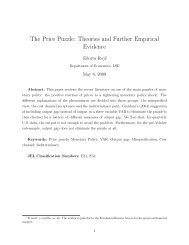Papel de trabajo_GMM
You also want an ePaper? Increase the reach of your titles
YUMPU automatically turns print PDFs into web optimized ePapers that Google loves.
aplicaciones se sitúan en el ámbito <strong>de</strong> la Econometría Financiera, pero es lo menos<br />
importante para nosotros. Lo interesante es ver cómo estimamos con las condiciones <strong>de</strong><br />
momentos que consi<strong>de</strong>remos oportunas según las condiciones <strong>de</strong>l mo<strong>de</strong>lo y cómo<br />
llevamos a cabo el contraste <strong>de</strong> restricciones sobrei<strong>de</strong>ntificadas.<br />
5.1. Contraste <strong>de</strong> restricciones sobrei<strong>de</strong>ntificadas:<br />
Tenemos los rendimientos diarios <strong>de</strong>l índice SP500 en un periodo <strong>de</strong> diez años, a los<br />
que llamaremos y t . Nos preguntamos si dichos rendimientos siguen una distribución<br />
normal. Si lo hicieran, las condiciones <strong>de</strong> momentos serían las siguientes:<br />
y t – μ = 0<br />
(y t – μ) 2 – σ 2 = 0<br />
(y t – μ) 3 / σ 3 = 0<br />
(y t – μ) 4 / σ 4 – 3 = 0<br />
Siendo μ =E[y t ], σ 2 = Var[y t ].<br />
Si en EViews le damos a estimar y ponemos <strong>GMM</strong> como método, obtenemos esta<br />
pantalla:<br />
En “equation specification” <strong>de</strong>beríamos escribir las ecuaciones <strong>de</strong> momentos <strong>de</strong>l<br />
mo<strong>de</strong>lo, mientras que en “instrument list” especificamos los instrumentos que vamos a<br />
utilizar. Sin embargo, en lugar <strong>de</strong> ir por este camino, se suele utilizar otro más cómodo,<br />
8



